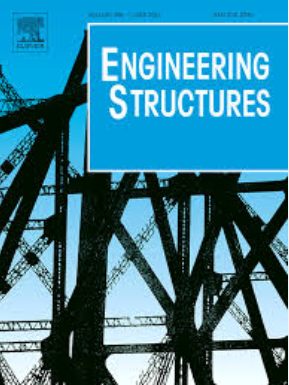Earthquake induced peak floor accelerations in multi-story self-centering concentrically braced frames
IF 5.6
1区 工程技术
Q1 ENGINEERING, CIVIL
引用次数: 0
Abstract
This study presents theoretical analysis and numerical simulations on the peak floor accelerations (PFAs) of self-centering concentrically braced frames (CBFs), considering it is a pressing need for estimating both structural and nonstructural damages. In the first part, two-degree-of-freedom (2DOF) systems with two flag-shaped springs are employed to elucidate the fundamental characteristics of accelerations. Grounded in structural dynamics, analytical equations are derived to qualitatively estimate peak accelerations of 2DOF systems. In the second part, the multi-story self-centering CBFs with four different story numbers are designed, based on the premise that they attain the same peak interstory drift ratio under the design basis earthquakes. In the nonlinear time history analysis (NLTHA), three suites of earthquake ground motions associated with three seismic hazard levels are employed to excite the structures into different degrees of nonlinearity. The NLTHA results demonstrate that the proposed analytical equations effectively explain the trends of PFAs in the self-centering CBFs. Furthermore, both the 2DOF analysis and seismic analysis of the buildings suggest that the increase of hysteretic parameters of braces could decrease PFAs. Notably, the PFAs are typically higher at the middle of the building than at the lower or upper stories during earthquakes. This phenomenon is elucidated by converting the multi-story frames into the equivalent 2DOF systems, where the equivalent mass ratio increases and equivalent initial stiffness ratios decreases along the structural height.
求助全文
约1分钟内获得全文
求助全文
来源期刊

Engineering Structures
工程技术-工程:土木
CiteScore
10.20
自引率
14.50%
发文量
1385
审稿时长
67 days
期刊介绍:
Engineering Structures provides a forum for a broad blend of scientific and technical papers to reflect the evolving needs of the structural engineering and structural mechanics communities. Particularly welcome are contributions dealing with applications of structural engineering and mechanics principles in all areas of technology. The journal aspires to a broad and integrated coverage of the effects of dynamic loadings and of the modelling techniques whereby the structural response to these loadings may be computed.
The scope of Engineering Structures encompasses, but is not restricted to, the following areas: infrastructure engineering; earthquake engineering; structure-fluid-soil interaction; wind engineering; fire engineering; blast engineering; structural reliability/stability; life assessment/integrity; structural health monitoring; multi-hazard engineering; structural dynamics; optimization; expert systems; experimental modelling; performance-based design; multiscale analysis; value engineering.
Topics of interest include: tall buildings; innovative structures; environmentally responsive structures; bridges; stadiums; commercial and public buildings; transmission towers; television and telecommunication masts; foldable structures; cooling towers; plates and shells; suspension structures; protective structures; smart structures; nuclear reactors; dams; pressure vessels; pipelines; tunnels.
Engineering Structures also publishes review articles, short communications and discussions, book reviews, and a diary on international events related to any aspect of structural engineering.
 求助内容:
求助内容: 应助结果提醒方式:
应助结果提醒方式:


